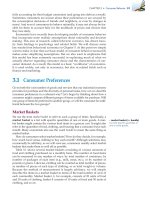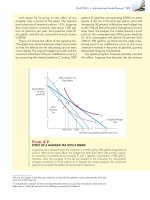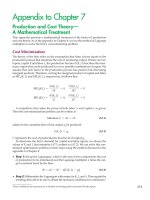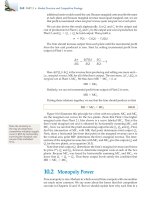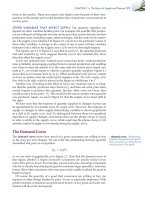(8th edition) (the pearson series in economics) robert pindyck, daniel rubinfeld microecon 94
Bạn đang xem bản rút gọn của tài liệu. Xem và tải ngay bản đầy đủ của tài liệu tại đây (100.4 KB, 1 trang )
CHAPTER 3 • Consumer Behavior 69
fully accounting for their budget constraints (and going into debt as a result).
Sometimes consumers are unsure about their preferences or are swayed by
the consumption decisions of friends and neighbors, or even by changes in
mood. And even if consumers do behave rationally, it may not always be feasible for them to account fully for the multitude of prices and choices that
they face daily.
Economists have recently been developing models of consumer behavior
that incorporate more realistic assumptions about rationality and decision
making. This area of research, called behavioral economics, has drawn heavily from findings in psychology and related fields. We will discuss some
key results from behavioral economics in Chapter 5. At this point we simply
want to make it clear that our basic model of consumer behavior necessarily
makes some simplifying assumptions. But we also want to emphasize that
this model has been extremely successful in explaining much of what we
actually observe regarding consumer choice and the characteristics of consumer demand. As a result, this model is a basic “workhorse” of economics.
It is used widely, not only in economics, but also in related fields such as
finance and marketing.
3.1 Consumer Preferences
Given both the vast number of goods and services that our industrial economy
provides for purchase and the diversity of personal tastes, how can we describe
consumer preferences in a coherent way? Let’s begin by thinking about how a
consumer might compare different groups of items available for purchase. Will
one group of items be preferred to another group, or will the consumer be indifferent between the two groups?
Market Baskets
We use the term market basket to refer to such a group of items. Specifically, a
market basket is a list with specific quantities of one or more goods. A market basket might contain the various food items in a grocery cart. It might also
refer to the quantities of food, clothing, and housing that a consumer buys each
month. Many economists also use the word bundle to mean the same thing as
market basket.
How do consumers select market baskets? How do they decide, for example,
how much food versus clothing to buy each month? Although selections may
occasionally be arbitrary, as we will soon see, consumers usually select market
baskets that make them as well off as possible.
Table 3.1 shows several market baskets consisting of various amounts of
food and clothing purchased on a monthly basis. The number of food items
can be measured in any number of ways: by total number of containers, by
number of packages of each item (e.g., milk, meat, etc.), or by number of
pounds or grams. Likewise, clothing can be counted as total number of pieces,
as number of pieces of each type of clothing, or as total weight or volume.
Because the method of measurement is largely arbitrary, we will simply
describe the items in a market basket in terms of the total number of units of
each commodity. Market basket A, for example, consists of 20 units of food
and 30 units of clothing, basket B consists of 10 units of food and 50 units of
clothing, and so on.
• market basket (or bundle)
List with specific quantities of
one or more goods.

